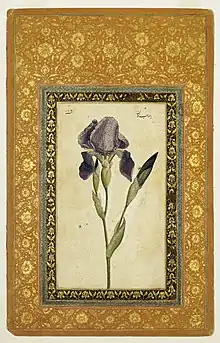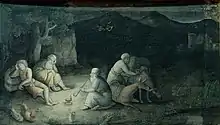Mohammad Zaman
Mohammad Paolo Zaman Kermani known as Mohammad Zaman (fl. 1680 – c. 1700), a famous Safavid calligrapher and painter.


Life
He was a native of Kerman, Persia. He received his education in Tabriz. He was sent to Rome under the reign of Shah Abbas II. He returned to Persia as a Catholic Christian with the name Paolo.[1] Because of his conversion to Roman Catholicism he was obliged to escape from Persia to India where he obtained the protection of the Moghul dynasty.
_Abu'l_Qasim_Firdausi_(935%E2%80%931020).jpg.webp)
Mohammad Zaman was influenced by Italian painting techniques. However, as Ivanov suggests, Mohammad Zaman studied under a European artist in Isfahan, Persia, and the report of his being sent by Shah Abbas II to study in Italy, where he adopted Roman Catholic Christianity, is no more than a colourful legend.[2]
It is reported that Manucci the famous traveller made the acquaintance of Mohammad Zaman at the court of Aurangzib.
References
- Lewis, Bernard (October 17, 2001). The Muslim Discovery of Europe. W. W. Norton & Company. ISBN 9780393245578 – via Google Books.
- History of Civilizations of Central Asia: Development in contrast : from the sixteenth to the mid-nineteenth by Chahryar Adle, Irfan Habib
Sources
- Habibi, Negar (2021). "Farangi-Sazi". In Yarshater, Ehsan (ed.). Encyclopædia Iranica, Online Edition. Encyclopædia Iranica Foundation.
- Landau, Amy S. (2011). "From Poet to Painter: Allegory and Metaphor in a Seventeenth-Century Persian Painting by Muhammad Zaman, Master of Farangī-Sāzī". Muqarnas Online. 28 (1): 101–131. doi:10.1163/22118993-90000175.
- Melville, Charles, ed. (2021). Safavid Persia in the Age of Empires: The Idea of Iran Vol. 10. I.B. Tauris. ISBN 978-0755633777.